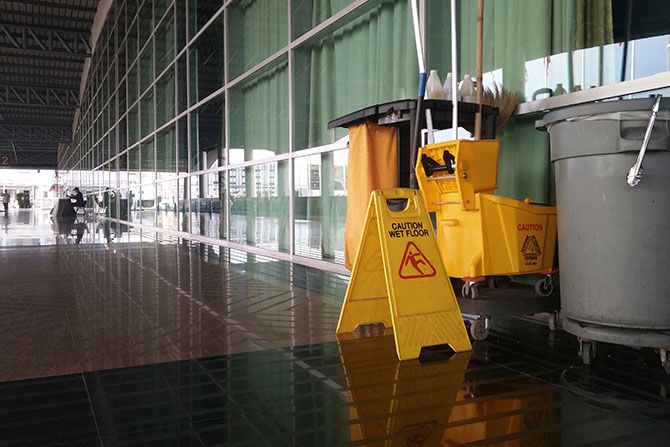While these mishaps might be commonplace, there is a proactive approach banks can take to help reduce the risk of their employees and customers being injured in a slip, trip and fall.
According to the National Safety Council, slips, trips and falls are the third leading cause of injury in the workplace. Some of these incidents occur at banks with employees or customers. While these mishaps might be commonplace, there is a proactive approach banks can take to help reduce the risk of their employees and customers being injured in a slip, trip and fall. A smart place to start: analyze both the physical conditions of the premises and usage and traffic flow patterns, which can often identify potential hazards that should be addressed.
Some of the accident causes are well known: wet spots on floors, uneven walking surfaces, and dirty doormats. Other factors, such as poor lighting, might not be as noticeable but can be equally dangerous.
“Banks should be aware of the potential for people falling and getting injured and should take steps to ensure the premises are as safe as possible,” said Laura Lundin, Vice President of Financial Institutions P&C at Travelers. “There are many ways to do this — maintain clean floor surfaces, ensure the space is well lit, schedule regular maintenance during low traffic times and conduct periodic walkthroughs to confirm everything looks safe. A little attention can go a long way.”
Working with an insurance carrier is also recommended. Insurance providers can work with banks to:
- Help identify and assess exposures;
- Develop loss control strategies and improvements to minimize the frequency and severity of slip, trip and fall incidents; and
- Provide training to help with slip, trip and fall prevention efforts.
If an accident does take place, be sure that it is documented and reported. This information can help prevent future incidents and may be essential if a claim is filed against the bank. A standard, printed incident report is helpful in ensuring that all details are recorded. Documenting the details of the incident, collecting the names and a brief statement from the injured party and any witnesses, and even taking photographs of the incident site can help. Slips, trips and falls rarely “just happen.”
Implementing effective slip, trip and fall improvements requires the right tools, people and communications. The right insurance carrier can help your slip, trip and fall prevention team define and document the policies, procedures, roles and responsibilities needed to effectively reduce these incidents. They also can help your team develop the tools and communication materials needed to implement this process.
Travelers is committed to managing and mitigating risks and exposures and does so backed by financial stability and a dedicated team — from underwriters to claim professionals — whose mission is to insure and protect a company’s assets. For more information, visit www.travelers.com.







